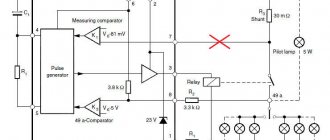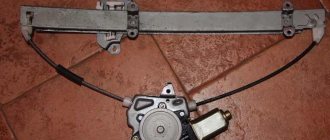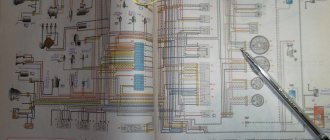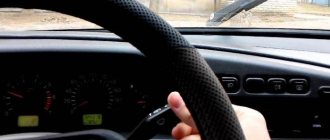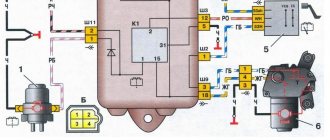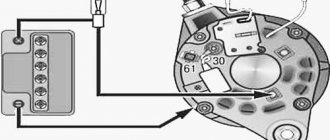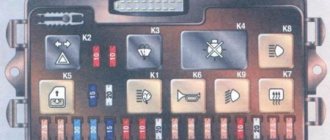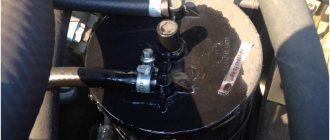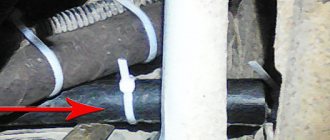Traffic regulations prescribe a special method of warning about maneuvers, which must be used if the turn signal lamps stop lighting on the road. Let's look at why turn signals don't work and how to eliminate the cause of the breakdown. We will talk about the design, operating principle and malfunctions of systems using turn signal relays based on integrated circuits. We will not consider old designs with bimetallic plates, as well as completely electronic systems, due to their specificity and low prevalence.
If only the front left or rear right turn signal on a car does not light up, the reason may be a burnt out light bulb, poor ground contact of the lights or a section of wire to the light bulb.
Causes of direction indicator malfunctions
- The fuse has blown. If the hazard warning lights stop working along with the turn signals, there is a high probability that the reason is the fuse link.
Instead of a blown fuse, install only an insert of the appropriate rating. Exceeding the recommended value and installing “bugs” can lead to a car fire. Therefore, we advise you to follow the rules for replacing fuses!
- Failure of the steering column switch.
- Damage to the turn signal relay.
- The hazard warning button is faulty.
- Open circuit. If the turn signals do not work on all sides, the first thing to check is the turn signal relay power wires. If the indicators stop working on only one side, the problem is in the wires running from the steering column switch to the light bulbs.
- Oxidized contacts, broken wires. The turn signals do not work if the circuit resistance differs significantly from the nominal value. To supply power, it is necessary to exceed a certain power level of consumers. If the microcircuit inside the turn signal relay does not register sufficient current due to increased resistance, power will not be supplied to the bulbs.
Device
The following are involved in the operation of turn signals:
- steering column turn switch. Its function is to close the power contact of the light bulbs. For example, when you turn the switch up, one of the contacts of the light bulbs on the right side closes to the “+” of the battery. The “minus” of the light bulb is the connection point to “ground” (the common point for all headlight bulbs);
- turn signal relay. There is a regular electromagnetic relay inside the case, but it is controlled by a microcircuit. It is thanks to this element that an intermittent power supply to the coil is ensured. The second important function is monitoring the health of the lamps. The microcircuit has a feedback function, so when a light bulb burns out, it registers a decrease in the power of consumers and begins to supply power to the coil at double the frequency. If the turn signals are working properly, the lights blink approximately once per second. Most modern cars, including VAZ models, use a 3-pin turn signal relay. Accordingly, 1 contact is “ground”, 2 – power supply from the battery, 3 – output to the steering column switch;
- light indication on the dashboard. One or two light bulbs (one on each side) are connected in parallel to the electrical circuit of the main lamps. The turn signals will work without a light indication, so the system should not be considered among the possible causes of the malfunction.
Connection diagram
The simplest turn signal connection diagram.
The video discusses in detail the principle of turning on the direction indicators, as well as the role of the hazard warning button in the operation of the system.
Frequent malfunctions of turn signals and emergency lights, and how to fix them
If the turning lights stop working, you need to carry out diagnostics and try to eliminate the identified faults. When you can’t do it yourself, you should contact a car service.
Turn switch
To identify such a breakdown, check the functionality of the contacts when the switch is in different positions. Inspect plastic or metal elements. In this case, melting or carbon deposits may appear. Then the relay clicks, but neither the right nor left turning mechanisms work.
We are looking for a breakdown with our own hands
Primary diagnostics can be carried out with a test light, but a tester is required to check the condition of the circuit. If you know how to use a multimeter, then in resistance measurement mode you can independently “ring” the wiring for a break.
The search for the reason why the turn signals and emergency lights stopped working should begin with studying the electrical circuit. We recommend that you refrain from self-repair if you are unfamiliar with the basics of electrical engineering and methods for restoring wiring.
If you clearly hear the relay clicking when you turn on the right/left turn signal, check the resistance of the section of the circuit with the steering column switch. If only the left or right side does not work, the reason is definitely in the switch or in the wiring of the circuit from it to the light bulbs.
If the turn signal relay does not click at all, check the condition of the contacts, the positive wire and ground. If, after turning on the ignition, “+” does not come to the relay, the problem is most likely in the section of the circuit from the mounting block to the relay.
Understeering's shifter
The cause of the malfunction can be either mechanical damage to plastic or contact elements, or the formation of carbon deposits. During operation of the turn signals, the contacts may burn out, which increases the resistance and reduces the current in the circuit. It is typical that in the case of oxides and carbon deposits, the indicator relay may click, but the lamps will not light up.
To repair the steering column switch, you will need to remove it from the steering column and disassemble it. There are many contact pads inside the case, so for trouble-free assembly, remember the location of all moving elements.
Removal and installation of pyrotechnic products requires compliance with safety regulations. Therefore, we recommend reading how to properly remove the airbag.
Where is it located and how to check the turn signal relay
The turn signal relay is located in the fuse box in the passenger compartment or under the hood. You can find out the exact location from the repair and operation manual of your car. Often on the inside of the mounting block the purpose of the relays and fuses is graphically depicted.
Soldering of elements from the circuit, microcracks in solder joints, failure of the main microcircuit are the most common causes of turn signal failure.
Why do the turn signals not work and what should I do?
Turning lights are an important part of the optical system of any car. They are designed to warn other drivers about a planned maneuver. There are many reasons why turn signals and hazard lights do not work. You can repair them yourself by first identifying the fault.
Types of problems and troubleshooting methods
The turn signal works correctly if the following indicators are met:
- the presence of the ignition on ensures the operating mode;
- moving the steering column switch up and down must be accompanied by turning on the turn signal on the corresponding side;
- The turn signal should flash at a rate of 60 cycles per minute.
Flashing at a certain frequency
Any other turn signal behavior indicates a problem. The most common causes of malfunctions include:
Non-blinking turn signal. The problem requires familiarity with the basic principle of relay operation: the current passing through the lamps leads to heating of the measuring resistor - an element that determines whether a particular lamp needs to be turned on. Consequently, the lamp resistance, different from the nominal one, changes the time the turn signal is turned on: it begins to blink. In this situation, it is recommended to lightly tap the relay (this helps if there is a weak connection or moisture). If you have replaced the relay, but the turn signal does not blink, but is constantly on, then there is poor contact with the fuse block. Replacing a fuse that was found to have a resistance value that does not correspond to the nominal value can also help.
Turn signal light
Stopping the operation of one turn signal is incompatible with a relay malfunction (problems of this type cause the operation of both turn signals to malfunction). One of the turn signals may fail due to a burnt-out light bulb (the simplest option) or a faulty wiring or socket. The new tab must not only fit into the turn signal socket, but also correspond to the power indicated on the lamp. If after replacing the light bulb the turn signal still does not start working, you need to pay attention to the socket. If there are traces of oxidation on it, then you should remove them. Sandpaper or a needle file works well for this. And if the light bulb is in too tight contact with the contacts, then you need to bend them with thin-nose pliers. This must be done as carefully as possible, preventing the contacts from closing, which can lead to another problem - the turn signals working in a checkerboard pattern. The normal state of the cartridge means that the cause of the malfunction lies in the wiring. First you need to make sure that the wire is securely connected to the socket. In this case, it is unacceptable for the wires to be closed to each other or to have a ground short to the metal body of the car. In this case, it is necessary to replace the wires or at least insulate them. If at the same time the hazard lights do not work, then the relay definitely needs to be changed - it is faulty.
A malfunction in the automatic shutdown can only be corrected in one way - replacing the switch. In case of such a breakdown, it is better to seek help from a specialist.
Does not burn
Also, the reason for the turn signal not working may be the switch itself. To check it, you need to get to the steering column switch and unmount it. By the way, if a problem occurs in the form of a hazard warning light that does not turn on when there are normally working turn signals, you just need to replace the button responsible for turning on the emergency lights.
A blinking turn signal too often is a sure sign that one of the light bulbs has burned out, or the chip in the tail light or the track in the mounting block has oxidized.
A dim turn signal light is a signal to check the suitability of the model and power. If everything is in order, then cleaning the contacts of the light bulbs can correct the situation.
Relay
A turn signal relay making a clicking sound is also not normal. The malfunction is hidden in the mounting block, or more precisely, in the relay contacts. Clicking sounds may occur if the contact is oxidized or is too tight. This can also be caused by a defective relay. The problem can be fixed by cleaning the contacts or installing a new relay.
Turn switch
A turn signal that does not work on one side, either front or rear, or in the repeater, indicates that the steering column switch is broken, there is no contact with it, or that the same relay has failed.
Priora fuse box
The turn signal circuitry is protected by an 8-amp fuse located in the mounting block. If it breaks down, turns will stop working on both the left and right sides of the car.
The light signaling system ensures traffic safety, so the driver should always have at least light bulbs of the required power with him.
